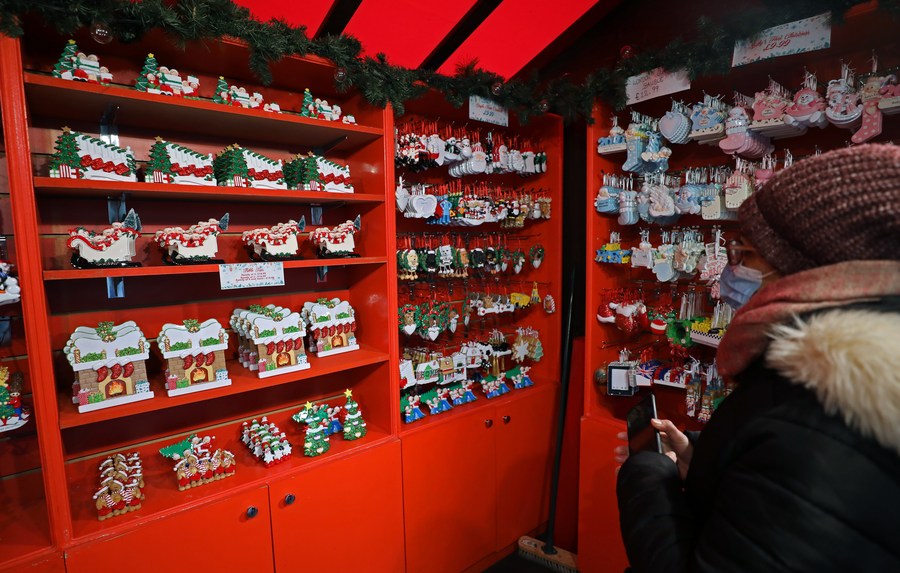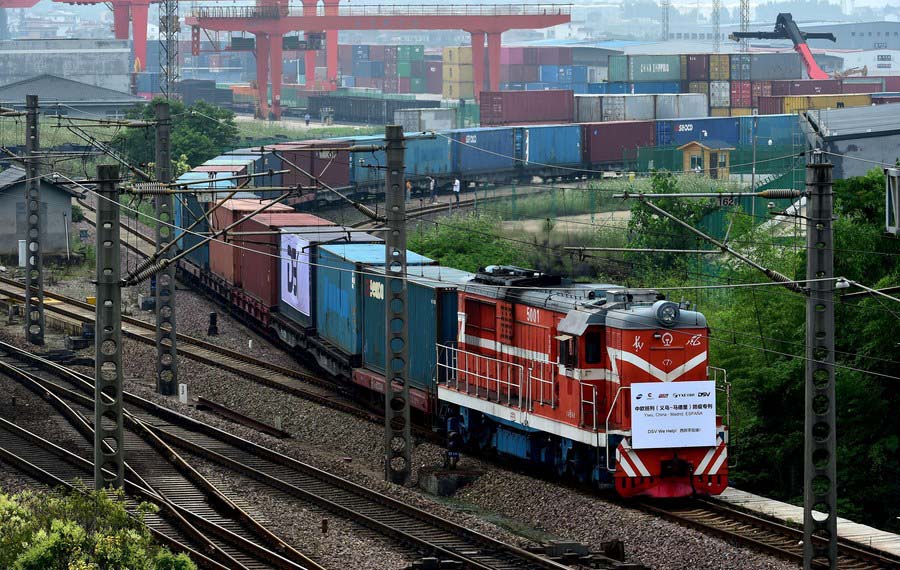Tackling inflation: How China is helping mitigate global price spikes
-- By providing a stable link between factories and consumers in a global supply chain shattered by COVID-19, the railway has been instrumental in stabilizing trade flows and combating soaring prices, which have emerged as the primary source of concern for world economies.
-- This year, inflation raged throughout the globe. In November, price rises in the eurozone and the United States hit 25-year and 39-year highs, respectively.
-- While many countries suffered from supply shortages, manufacturers in China continued to work in full throttle and exported goods in a stable and timely manner, which effectively helped close the supply-demand gap and alleviate skyrocketing prices.
BEIJING, Dec. 25 (Xinhua) -- Jiang Tong, an experienced driver of the China-Europe freight train, never encountered a year busier than 2021.
Jiang, responsible for the section between southwest China's Chongqing and Dazhou of Sichuan, said his workload surged amid the COVID-19 pandemic. "Earlier, we could take a six-hour break after the arrival of the train in Dazhou, but now the instruction to return comes upon our arrival."
Train trips on this great freight route spanning Eurasia totaled 13,817 in the first 11 months of this year, up 23 percent year on year, with 1.33 million 20-foot equivalent units of goods handled, up 30 percent.
"We have been on the go," Jiang said.
Thanks to workers like Jiang, made-in-China festive goods from Christmas trees to costumes and toys were transported swiftly and safely to marketplaces some 10,000 km away ahead of Christmas and New Year's Day.

A woman views Christmas ornaments made in China in a Christmas market at Trafalgar Square in London, Britain, Dec. 23, 2021. (Xinhua/Li Ying)
By providing a stable link between factories and consumers in a global supply chain shattered by COVID-19, the railway has been instrumental in stabilizing trade flows and, most importantly, in combating soaring prices, which have emerged as the primary source of concern for world economies, large or small.
This year, inflation raged throughout the globe. In November, price rises in the eurozone and the United States hit 25-year and 39-year highs, respectively, increasing the cost of living for ordinary people and posing a danger to economies that have yet to recover to pre-pandemic levels.
Analysts attributed the price spikes in consumer products to multiple factors, in particular overly-loosened monetary policies adopted by some central banks around the globe, or "money printing," which were designed to spur sluggish economic activities and rescue businesses and individuals struggling to keep afloat.
The economic stimulus by some Western countries has proved to be excessive and the loosening in monetary policies has as far been less effective, Liang Haiming, chairman of China Silk Road iValley Research Institute, said, pointing to serious side-effects such as high inflationary pressure.
Liao Qun, chief economist of Chongyang Institute for Financial Studies, Renmin University of China, cited some other price drivers, including disrupted supply chains and expensive commodities.
"We saw suspended production in factories of many manufacturing countries and congestion at ports and railway stations," Liao said. "Prices of commodities, such as natural gas and other energy sources, also rose, aggravating the problem."
While the causes of inflation are obvious, there have been baseless assertions that China, with its factories making a significant number of consumer goods and exporting them globally, should take the blame for rising prices globally.

Aerial photo taken on Feb. 17, 2020 shows a China-Europe freight train fully loaded with auto parts, mechanical facilities and garments bound for Moscow of Russia and Minsk of Belarus waiting for departure at Xiangtang railway port in Nanchang, east China's Jiangxi Province. (Xinhua/Hu Chenhuan)
Julian Evans-Pritchard, senior China economist at the British think-tank Capital Economics, has refuted such arguments.
"Some believe that China is adding to global inflationary pressure. The opposite is closer to the truth," he stated in an article titled "No, China isn't exporting inflation," noting that "global consumer goods prices are rising in spite of China, not because of it."
China was hit hard by the pandemic, but its economy roared back swiftly and has made significant contributions to global anti-pandemic efforts, churning out medical supplies and daily necessities and shipping them to markets in the rest of the world.

A China-Europe freight train carrying medical supplies bound for Madrid of Spain departs from the city of Yiwu, east China's Zhejiang Province, June 5, 2020. (Photo by Lyu Bin/Xinhua)
While many countries suffered from supply shortages, manufacturers in China continued to work in full throttle and exported goods in a stable and timely manner, which effectively helped close the supply-demand gap and alleviate skyrocketing prices, Liao said.
"The world would have faced a much worse scenario if China had not controlled the pandemic quickly and restored its production lines," he added.
Observers believe that it is politically biased to scapegoat Chinese factories for global inflation and such finger-pointing is in essence aimed at finding excuses for failures in battling the pandemic and bolstering the economy.
Looking ahead, the world remains vulnerable to volatility and uncertainty, with resurgences in COVID-19 outbreaks due to the new variant Omicron and impacts from monetary policy shifts in Western countries.
The globe needs a stable Chinese economy and a vibrant manufacturing powerhouse to overcome inflation and lead the recovery, Liang said.
According to the World Bank's latest predictions, China's real GDP growth will reach 8 percent this year and moderate mildly to a still-solid 5.1 percent in 2022, and that its "momentum is expected to pick up, aided by a more supportive fiscal stance."
Photos
Related Stories
Copyright © 2021 People's Daily Online. All Rights Reserved.










